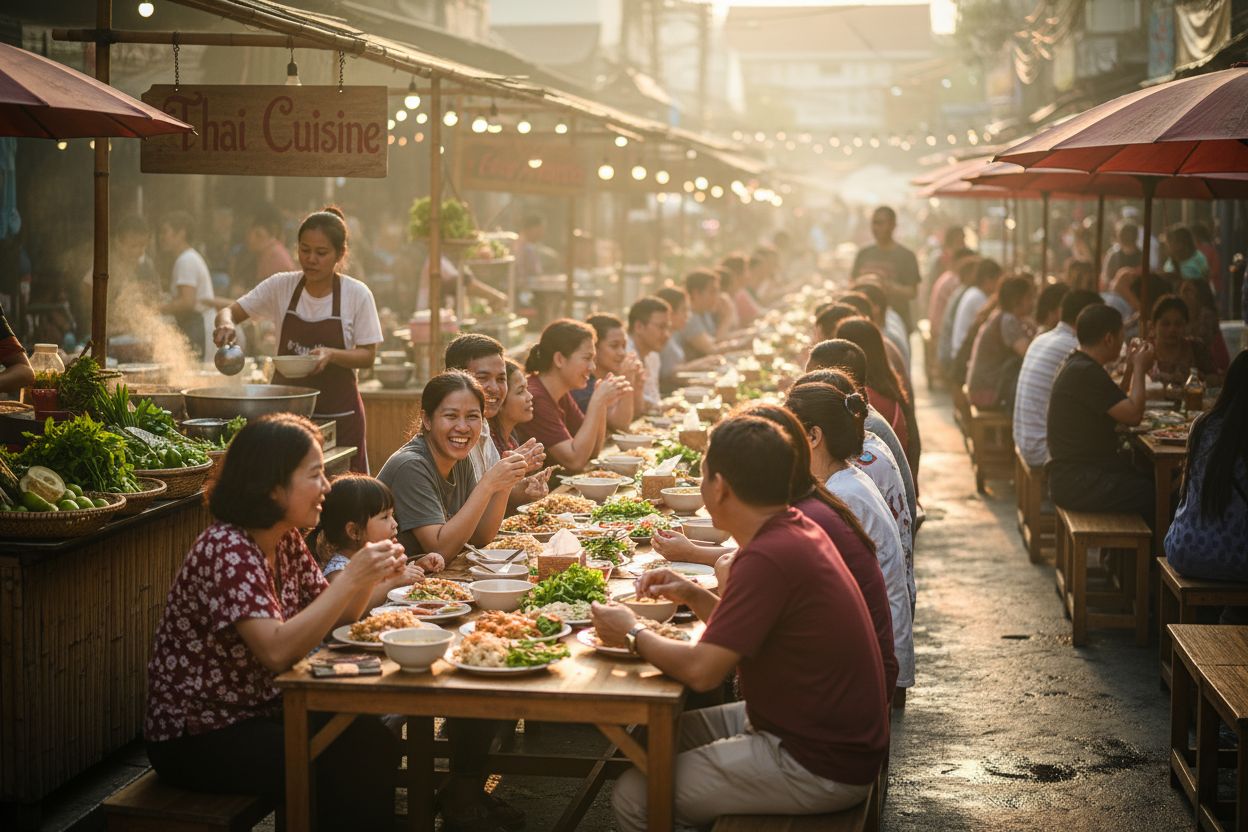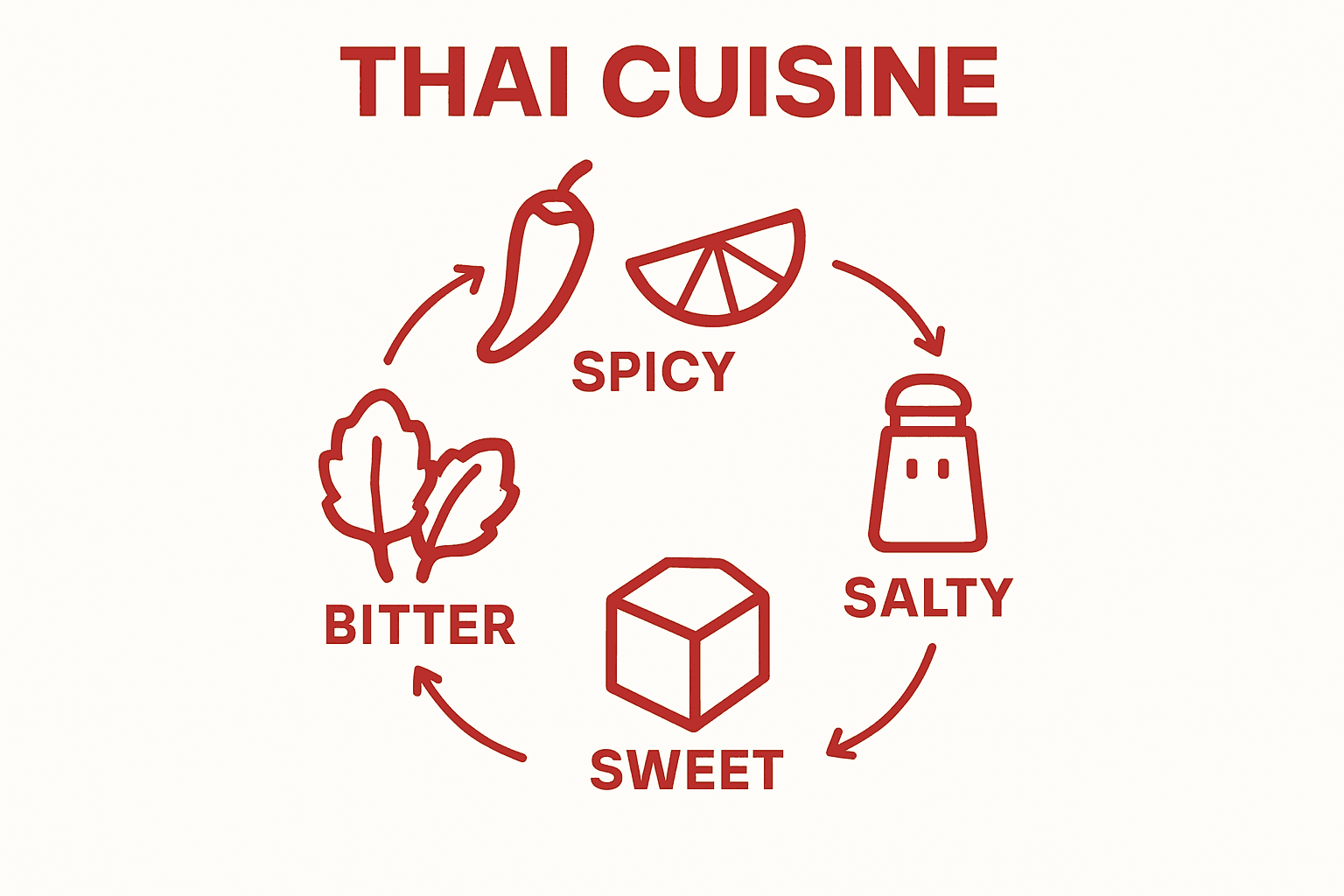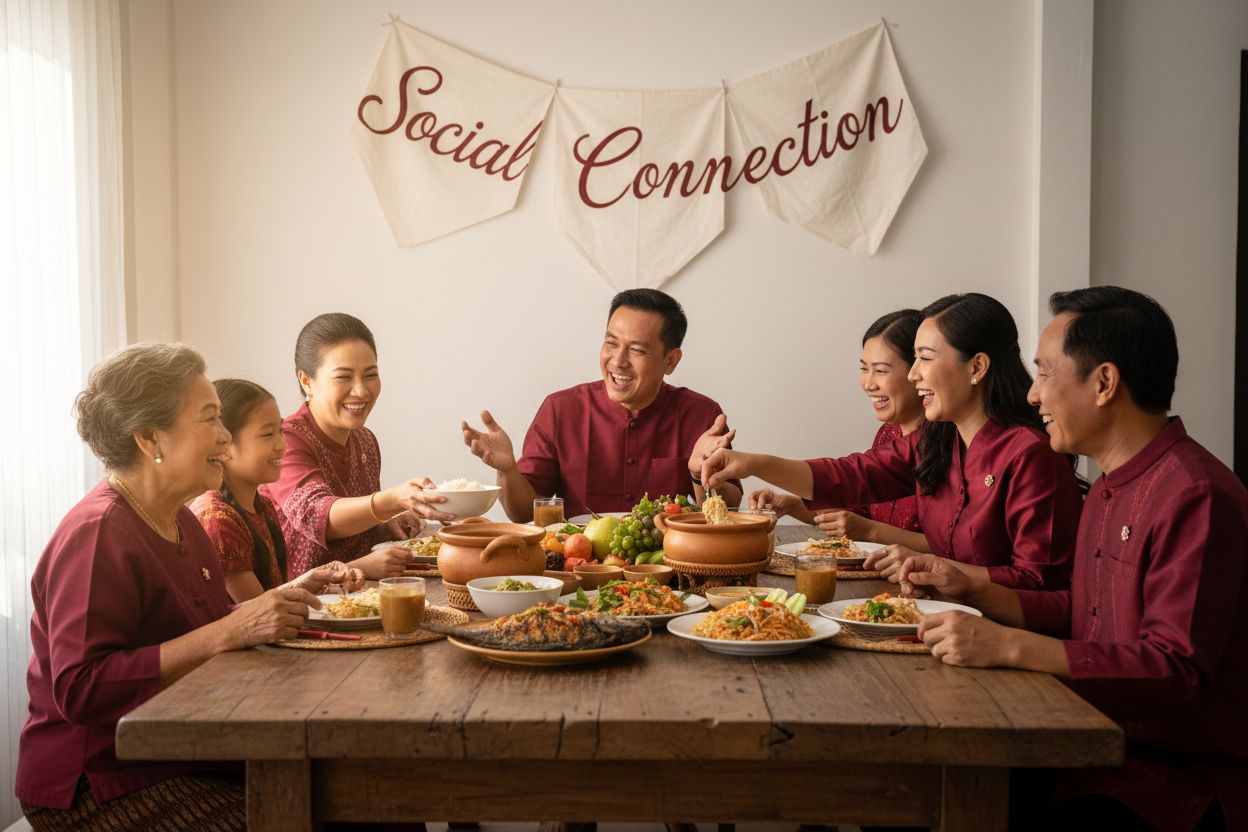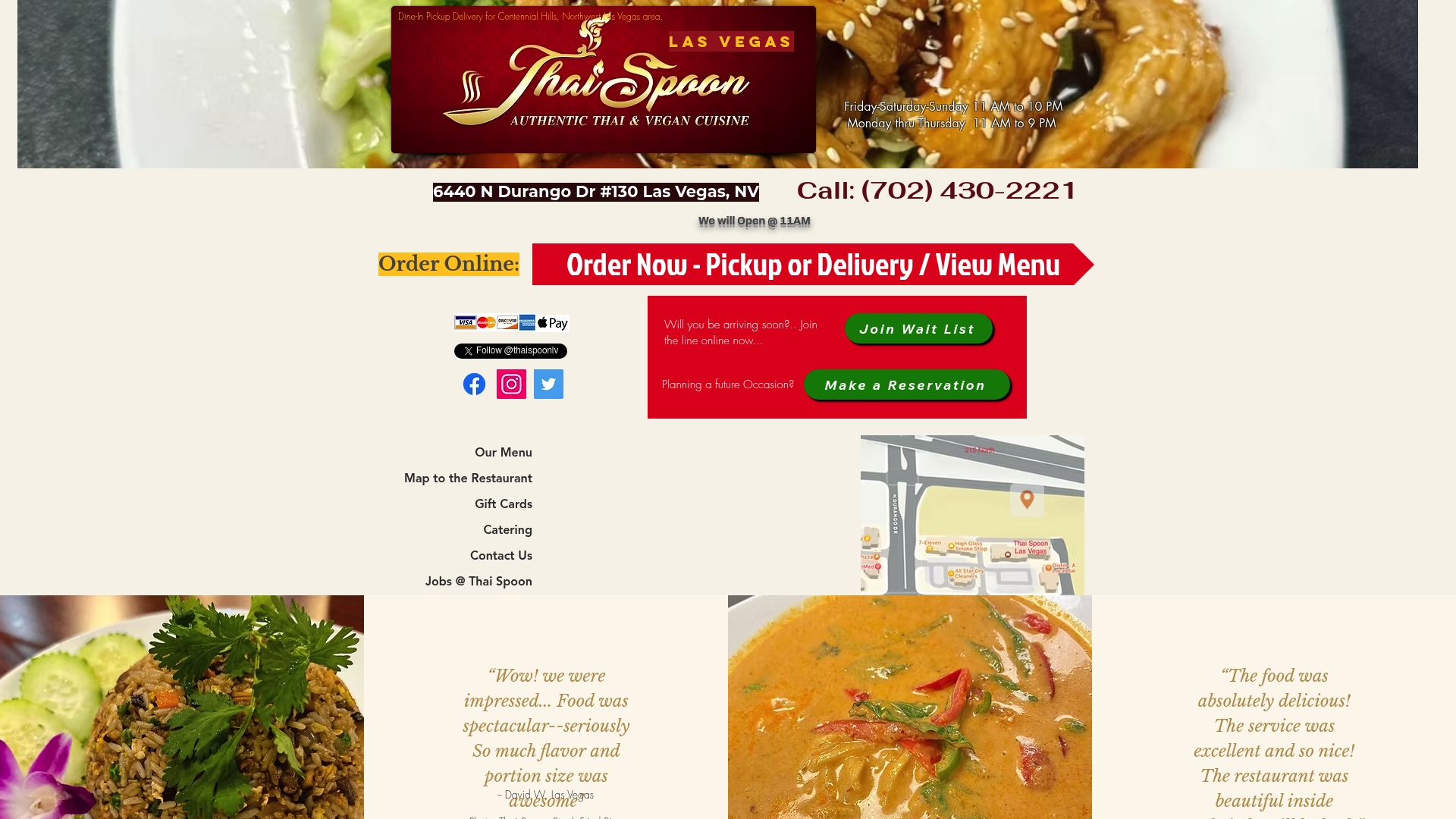What is Thai Cuisine Culture? Understanding Its Richness
- mail469793
- Oct 1
- 10 min read

Thai cuisine is famous for dishes that make your taste buds jump, but did you know that Thai cooking actually balances five different flavors in every meal: sweet, sour, salty, bitter, and spicy? Most people expect familiar tastes from Asian food, only to find themselves surprised by the complexity packed into even the simplest plate of noodles. It turns out that every ingredient, from lemongrass to chili, is picked not just for taste but to create a harmony that reflects Thai culture itself.
Table of Contents
Quick Summary
Takeaway | Explanation |
Thai cuisine balances five essential flavors | The perfect harmony of sweet, sour, salty, bitter, and spicy creates a unique taste experience. |
Key ingredients define authentic Thai dishes | Lemongrass, kaffir lime leaves, and Thai basil are crucial for achieving genuine Thai flavors. |
Food serves as a cultural connection | Sharing meals fosters community bonding and breaks down social barriers in Thai culture. |
Thai cooking embodies a philosophy of balance | Each dish is crafted to ensure no single flavor dominates, reflecting cultural values of harmony. |
Tradition evolves with modern influences | Contemporary trends integrate global flavors and sustainable practices while preserving core Thai elements. |
The Essence of Thai Cuisine: Flavors and Ingredients
Thai cuisine represents a vibrant culinary tradition that beautifully balances complex flavor profiles, creating an extraordinary sensory experience. Explore our authentic Thai cuisine guide to understand the intricate world of Thai cooking.
The Five Fundamental Flavor Components
At the heart of Thai cuisine lies a sophisticated understanding of flavor balance. Unlike many culinary traditions that focus on two or three taste dimensions, Thai cooking masterfully integrates five key flavor components: sweet, sour, salty, bitter, and spicy. This intricate balance creates dishes that are simultaneously complex and harmonious.

Each recipe carefully orchestrates these flavors through strategic ingredient selection. For instance, palm sugar introduces sweetness, tamarind provides sourness, fish sauce contributes saltiness, fresh herbs offer bitterness, and chili peppers deliver heat. The result is a symphony of tastes that dance across the palate.
The following table summarizes the key flavor components of Thai cuisine, the main ingredients that deliver each flavor, and examples of dishes where these flavors are prominent.
Flavor Component | Typical Ingredient(s) | Example Dish |
Sweet | Palm sugar | Pad Thai |
Sour | Tamarind, lime | Tom Yum Soup |
Salty | Fish sauce, soy sauce | Green Curry |
Bitter | Fresh herbs, bitter melon | Nam Prik Noom |
Spicy | Chili peppers | Som Tam (Papaya Salad) |
Essential Ingredients that Define Thai Cooking
Three fundamental ingredients form the backbone of Thai cuisine, transforming ordinary meals into extraordinary culinary experiences:
Lemongrass: A fragrant herb that adds citrusy notes and depth to curries and soups
Kaffir Lime Leaves: Providing an intense, aromatic flavor unique to Southeast Asian cooking
Thai Basil: A peppery, anise-like herb that distinguishes Thai dishes from other Asian cuisines
These ingredients are not mere garnishes but critical components that define the authentic Thai flavor profile. They represent generations of culinary wisdom, passed down through family recipes and regional cooking traditions.
Culinary Philosophy of Balance and Harmony
Beyond ingredients, Thai cuisine embodies a philosophical approach to food preparation. Each dish is conceived as a balanced composition, where no single flavor overwhelms another. This principle reflects broader Thai cultural values of harmony, respect, and interconnectedness.
The complexity of Thai cuisine goes far beyond simple recipe execution. It represents a profound understanding of how different ingredients interact, how heat transforms flavors, and how presentation contributes to the overall dining experience. From street food to royal cuisine, this commitment to balance remains constant, making Thai food a globally respected culinary tradition.
The Cultural Significance of Thai Food in Society
Thai cuisine transcends mere sustenance, representing a profound cultural expression deeply woven into the social fabric of Thailand. Learn more about Thai culinary traditions to understand its rich societal importance.
Food as Social Connection and Communication
In Thai culture, food serves as a powerful medium of social interaction and communication. Sharing meals is not simply about nutrition but a ritual of community bonding, respect, and hospitality. Family gatherings, religious ceremonies, and social events are fundamentally defined by communal eating experiences where multiple dishes are shared collectively.
The practice of “Khao Niao” (communal rice eating) symbolizes unity and equality. Everyone gathered around a shared plate represents democratic principles of access and collective experience. This dining approach breaks down social hierarchies, creating moments of genuine human connection.

Culinary Traditions and Spiritual Practices
Thai cuisine is deeply intertwined with spiritual and religious practices, reflecting a holistic understanding of food beyond physical nourishment. Buddhist traditions significantly influence food preparation and consumption, emphasizing mindfulness, gratitude, and interconnectedness.
Key spiritual connections in Thai food culture include:
Offerings to Monks: Preparing food as a sacred act of merit-making
Temple Festivals: Cooking as a form of spiritual community engagement
Seasonal Ceremonies: Specific dishes prepared to honor ancestral traditions
Economic and Historical Dimensions
Traditionally, Thai cuisine developed through complex interactions of trade, agricultural practices, and cultural exchanges. The geographic location of Thailand made it a crossroads of culinary influences from China, India, and neighboring Southeast Asian countries.
Street food culture, particularly in urban centers like Bangkok, represents more than economic activity. It embodies social mobility, entrepreneurship, and collective urban identity. Street vendors are not just food providers but storytellers preserving generational cooking techniques and regional flavor variations.
Through its rich culinary landscape, Thai food communicates stories of resilience, creativity, and cultural pride, transforming everyday meals into profound expressions of national identity.
Regional Differences in Thai Culinary Traditions
Thai cuisine is not a monolithic culinary tradition but a complex tapestry of regional flavors, ingredients, and cooking techniques. Discover the unique spices that define Thai regional cooking to appreciate the diversity of this remarkable cuisine.
Northern Thai Cuisine: Mild and Herbal Influences
Northern Thai cuisine, centered around Chiang Mai, distinctly differs from other regional styles. Characterized by milder flavors and significant Burmese and Laotian influences, this culinary tradition emphasizes sticky rice, herb-infused dishes, and subtle seasoning.
Key features of Northern Thai cooking include:
Khao Soi: A coconut curry noodle soup unique to the region
Nam Prik Noom: A green chili pepper dip representing local flavor profiles
Sai Oua: A herbaceous northern Thai sausage packed with local spices
Northeastern (Isaan) Cuisine: Bold and Rustic Traditions
Isaan cuisine represents perhaps the most distinctive regional cooking style in Thailand. Bordered by Laos, this region develops bold, spicy dishes that reflect agricultural lifestyles and limited resources. Fermentation and grilling techniques dominate Isaan cooking, creating intensely flavorful meals.
The cuisine is characterized by raw ingredients, powerful seasonings, and a focus on communal eating. Sticky rice, grilled meats, and fiery som tam (papaya salad) form the cornerstone of Isaan culinary traditions.
Southern Thai Cuisine: Coastal Influences and Intense Flavors
Southern Thai cooking emerges from a landscape of coastal regions and dense tropical forests. Influenced by maritime trade and proximity to Malaysia, this region produces incredibly complex and spicy dishes. Coconut, seafood, and intense spice blends define Southern Thai cuisine.
Unique characteristics include heavy use of turmeric, abundant seafood preparations, and rich curries that differ dramatically from central Thai cooking styles. Dishes like Massaman curry showcase the region’s multicultural culinary heritage, blending Malaysian, Persian, and Thai flavor profiles.
These regional variations demonstrate that Thai cuisine is not a single, uniform tradition but a dynamic, evolving culinary landscape reflecting geographic diversity, cultural exchanges, and local agricultural practices.
This table compares the three major regional styles of Thai cuisine, highlighting their flavor profiles, typical ingredients, and representative dishes for easy reference.
Region | Flavor Profile | Typical Ingredients | Example Dish |
Northern Thailand | Mild, herbal, less spicy | Sticky rice, fresh herbs, turmeric | Khao Soi |
Northeastern (Isaan) | Bold, spicy, rustic, fermented | Chili, fermented fish sauce, grilled meats | Som Tam (Papaya Salad) |
Southern Thailand | Intense, spicy, coconut, seafood | Coconut milk, seafood, turmeric | Massaman Curry |
The Role of Thai Cuisine in Social Gatherings and Festivals
Food in Thai culture transcends mere consumption, serving as a powerful social glue that connects people across generations and communities. Explore our comprehensive guide to Thai catering for events to understand how food brings people together.
Festivals and Ceremonial Food Traditions
Thai festivals are incomplete without their signature culinary experiences. Each celebration features specific dishes that carry deep symbolic meanings, transforming food into a narrative of cultural identity and spiritual significance. During Songkran (Thai New Year), families prepare special dishes like Khao Chae, a cooling rice dish symbolizing renewal and purification.
Key festival food traditions include:
Merit-Making Meals: Preparing food offerings for Buddhist monks during religious ceremonies
Harvest Celebrations: Special dishes commemorating agricultural cycles and community prosperity
Family Reunion Feasts: Elaborate meals that reinforce familial bonds and ancestral connections
Community Bonding Through Communal Dining
Communal dining represents more than a meal in Thai culture. It is a profound social ritual that breaks down hierarchical barriers and creates genuine human connections. Large gatherings where multiple dishes are shared simultaneously embody principles of equality and collective experience.
Street food markets and community festivals exemplify this social dining philosophy. People from different social backgrounds gather around shared tables, enjoying diverse dishes that encourage interaction and mutual understanding. The act of sharing food becomes a democratic experience that transcends social boundaries.
Ritual and Symbolism in Culinary Practices
Thai cuisine transforms food preparation into a ritualistic practice laden with symbolism. Certain dishes are prepared not just for nutrition but as expressions of respect, gratitude, and spiritual connection. Wedding ceremonies, ancestor remembrance events, and agricultural festivals all feature meticulously prepared dishes that communicate complex cultural narratives.
The preparation process itself becomes a collective activity. Families and community members often collaborate in cooking, turning meal preparation into a social event that strengthens interpersonal relationships. Each ingredient, cooking technique, and presentation method carries layers of cultural meaning, making Thai cuisine a living, breathing cultural expression.
Modern Influences on Traditional Thai Cuisine
Traditional Thai cuisine continues to evolve, absorbing global culinary trends while maintaining its authentic core. Learn about the exciting world of Thai fusion cuisine and how modern influences are transforming classic recipes.
Global Culinary Exchanges
Modern Thai cuisine reflects a dynamic interaction between traditional techniques and contemporary global food trends. Chefs and home cooks are increasingly experimenting with ingredient combinations, cooking methods, and presentation styles that blend international influences with classic Thai flavor profiles.
Key areas of culinary innovation include:
Ingredient Adaptation: Incorporating non-traditional ingredients like quinoa, kale, and plant-based proteins
Cooking Technique Fusion: Blending Thai seasonings with Western cooking methods like sous-vide and molecular gastronomy
Dietary Trend Integration: Creating gluten-free, vegan, and health-conscious Thai-inspired dishes
Technology and Food Culture
Digital platforms and social media have dramatically accelerated culinary innovation in Thai cuisine. Food bloggers, international chefs, and home cooking enthusiasts share recipes, techniques, and flavor experiments that challenge traditional boundaries. Online platforms enable rapid knowledge exchange, allowing Thai cuisine to evolve more quickly and globally than ever before.
Restaurants and food entrepreneurs are leveraging technology to create immersive dining experiences. Virtual cooking classes, recipe-sharing platforms, and international food delivery services have made Thai cuisine more accessible and adaptable to global tastes.
Sustainability and Ethical Eating
Contemporary Thai cuisine is increasingly influenced by global sustainability movements. Chefs are reimagining traditional recipes through the lens of environmental consciousness, focusing on locally sourced ingredients, reduced carbon footprint, and ethical food production.
This shift encompasses more than ingredient selection. It represents a holistic approach to food that respects both cultural heritage and contemporary ecological challenges. Farm-to-table practices, reduced meat consumption, and support for local agricultural communities are becoming integral to modern Thai culinary philosophy.
These modern influences demonstrate that Thai cuisine is not a static tradition but a living, breathing culinary landscape continuously adapting to global changes while preserving its fundamental character and flavor principles.
Experience the True Richness of Thai Cuisine Culture in Las Vegas
After learning about the balance of flavors, regional diversity, and cultural meaning that shape authentic Thai cuisine, you might wonder where you can truly experience these vibrant traditions in your own community. The struggle to find genuine, harmonious Thai flavors—especially those prepared with care for gluten-free or vegan needs—can leave food lovers feeling unsatisfied and disconnected from the very essence described in our article. At Thai Spoon Las Vegas, we uphold Thailand’s culinary philosophy of harmony and community, offering dishes celebrated for their authenticity and bold taste.

Your next memorable meal awaits just 20 minutes from the Strip. Whether you crave the creamy complexity of Yellow Curry or the aromatic freshness of our vegan options, we bring the richness of Thai food culture straight to your table. Explore our menu inspired by traditional Thai cooking or order for pickup and delivery on our website. Do not miss the chance to experience a true taste of Thailand right here in northwest Las Vegas. Reserve your table, plan your next gathering, or treat someone special with a gift card today.
Frequently Asked Questions
What are the five fundamental flavors of Thai cuisine?
Thai cuisine is characterized by a balance of five key flavor components: sweet, sour, salty, bitter, and spicy. Each dish is crafted to harmonize these flavors, creating a unique and complex taste experience.
What are some essential ingredients in Thai cooking?
Key ingredients that define Thai cuisine include lemongrass, varying types of peppers, kaffir lime leaves, and Thai basil. These ingredients contribute distinct flavors that are central to the authenticity of Thai dishes.
How does Thai cuisine reflect cultural values?
Thai cuisine reflects cultural values such as balance, harmony, and community bonding. Meals are often shared among family and friends, representing unity and equality within the dining experience.
How do festivals influence Thai culinary traditions?
Festivals in Thailand are an integral part of culinary traditions, featuring specific dishes that symbolize cultural identity. Foods prepared during celebrations often carry spiritual meanings and reinforce family and community connections.
Recommended









Comments